Gangster VIP 2 Blu-ray Movie
HomeGangster VIP 2 Blu-ray Movie 
Blu-ray + DVDArrow | 1968 | 97 min | Not rated | No Release Date
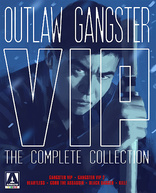
Price
Movie rating
6.9 | / 10 |
Blu-ray rating
| Users | 0.0 | |
| Reviewer | 3.5 | |
| Overall | 3.5 |
Overview
Gangster VIP 2 (1968)
A yakuza enforcer attempts to put his dark past behind him but is dragged back to his old ways.
Starring: Tetsuya Watari, Chieko Matsubara, Ryōhei Uchida, Jirō Okazaki, Kunie TanakaDirector: Keiichi Ozawa
| Foreign | Uncertain |
| Crime | Uncertain |
| Action | Uncertain |
Specifications
Video
Video codec: MPEG-4 AVC
Video resolution: 1080p
Aspect ratio: 2.44:1
Original aspect ratio: 2.35:1
Audio
Japanese: LPCM Mono
Subtitles
None
Discs
50GB Blu-ray Disc
Two-disc set (1 BD, 1 DVD)
DVD copy
Playback
Region A (B, C untested)
Review
Rating summary
| Movie | 3.5 | |
| Video | 3.5 | |
| Audio | 3.5 | |
| Extras | 1.0 | |
| Overall | 3.5 |
Gangster VIP 2 Blu-ray Movie Review
Reviewed by Jeffrey Kauffman April 24, 2016Note: This film is currently available as part of the Outlaw: Gangster VIP Collection.
It’s certainly not a scientific survey by any stretch of the imagination, but when I quizzed a coterie of Japanese film fan friends of mine to
name a
Japanese film studio, absolutely no one came up with Nikkatsu. Toho was quite popular, as was Toie, but Japan’s oldest studio didn’t even
rate one single, solitary mention. Nikkatsu’s rather redolent history goes all the way back to 1912, easily eclipsing Toho’s genesis circa 1932
or Toie’s origination a few years later in 1938. For whatever reason, though, Nikkatsu, despite its status as the “dean” of Japanese movie
studios, doesn’t seem to have the same general notoriety that some of its competitors do. Nikkatsu may be best remembered by at least
some fans for its so-called “pink film” era, a kind of quasi-soft porn (sometimes maybe a little “harder” than merely soft) approach that
helped the studio weather the roiling 1970s era, when big studios, no matter where they might be located, were facing a rapidly changing
set of demographics and an often frustrating and potentially life threatening new set of economic challenges. One of Nikkatsu’s pre-pink era
calling cards was a short-lived but temporarily almost insanely popular franchise which began with 1968’s Gangster VIP, which is also
known by the slightly different title Outlaw: Gangster VIP. As Jasper Sharp mentions on his commentary for the first film of this new
six film set, the kind of ironic thing about this series coming out of Nikkatsu is that Toie had already staked a claim of sorts on the Japanese
gangster film idiom, kind of like Warner Brothers did in the United States back in the 1930s. The Outlaw: Gangster VIP series wasn’t
very long lived, lasting only around two years from 1968-1969, but it’s a really interesting aggregation of films that should appeal to lovers of
yakuza fare or even those who simply like to ferret out largely unseen entries that have been hidden in the various nooks and crannies of
Japanese cultdom for decades.

If the IMDb is to be believed, it only took four months or so between the release of Gangster VIP and this first follow up, a probably salient indication of how popular the first film must have been. There’s little doubt that Gangster VIP 2 falls rather solidly into several plot dynamic ruts that had been well established in the first film, with Goro Fujikawa (Tetsuya Watari) really wanting out of the yakuza lifestyle this time around, and once again attempting to navigate a dangerous “professional” life with a hopefully more peaceful one with his would be girlfriend Yukiko (Chieko Matsubara).
Somewhat oddly, though, Gangster VIP 2 doesn’t follow a traditional romantic arc, instead positing another woman named Yumeko (Kayo Matsuo) who at least captures Goro’s more honorable instincts if not his amorous eye. (Certain elements of Gangster VIP 2 show up in slightly altered form in Heartless, and indeed for those who watch these films in quick succession, there’s an almost maddening interchangeability between certain plot points and characters that waft in and out of the various entries.) Once again a long ago friend turns out to be a nemesis for Goro, though in this particular instance there’s more of a clear cut “Jets vs. Sharks” ambience (to utilize an adversarial gang relationship known to most Western viewers) instead of long standing enemies suddenly becoming unlikely allies.
There’s a bit more emphasis in this film on Goro (and even some other yakuza) wanting to get out of the crime world and “go straight”, and there’s the continuing emphasis on the role of women in this niche of Japanese society that was also part and parcel of the first film. The narrative here is a little more hackneyed than in the first film, but characterization and performances continue to be winning, and there are some well done fight sequences.
Note: Our scoring system can be a little frustrating at times, especially when dealing with a franchise like this. I'm rating the two first films at 3.5 overall, though I would give this a 3.75 and the second a 3.25 if I were able to.
Gangster VIP 2 Blu-ray Movie, Video Quality 
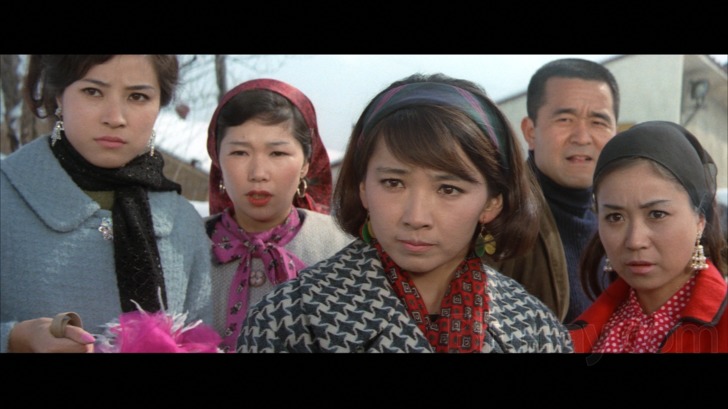
Gangster VIP 2 is presented on Blu-ray courtesy of Arrow Films with an AVC encoded 1080p transfer in 2.44:1. All six films in the
Outlaw
Gangster VIP franchise share some common characteristics, and so I will be offering some general assessments that pertain to the series
as a whole before moving on to more specific comments about this particular film. Arrow's brief comments on the provenance of the elements
utilized for these transfers mentions only that "The Outlaw Gangster VIP series was transferred from original preservation film elements
by Nikkatsu Studios in Japan. All six films were delivered to Arrow Films as remastered files." This unfortunately doesn't really provide a lot of
information, and it's my assumption that at least some of these may have been transferred from secondary sources like prints rather than IPs or
negatives. Several of the films have recurrent brightness and contrast fluctuations which are quite noticeable and create a kind of slow motion
quasi-flicker, with clear gradations in tones especially visible in darker moments. While elements show various signs of wear and tear, and
feature slight fading which tends to skew flesh tones toward the brown side of things, palettes are overall quite convincing and robust, especially
when it comes to aspects like the bright red blood that flows so ubiquitously in each of the entries.
This film has a rather robust and age defying palette, though it like its immediate predecessor can look a little over bright at times. One of the
odder things about some of the films in this set is their 2.44:1 aspect ratios, and there were occasional moments when things looked just slightly
"squished" horizontally, with (to cite one example) faces seeming a bit too wide. This is a very slight anomaly and I'm still not certain it's
a "problem", but felt it was worth mentioning. Detail is perhaps even a bit more consistently pleasing in this film than the first, with things like pill
on fabrics clearly visible in close-ups. This film also exhibits very little of the contrast and brightness fluctuations that are apparent in some of the
other films in this set.
Gangster VIP 2 Blu-ray Movie, Audio Quality 
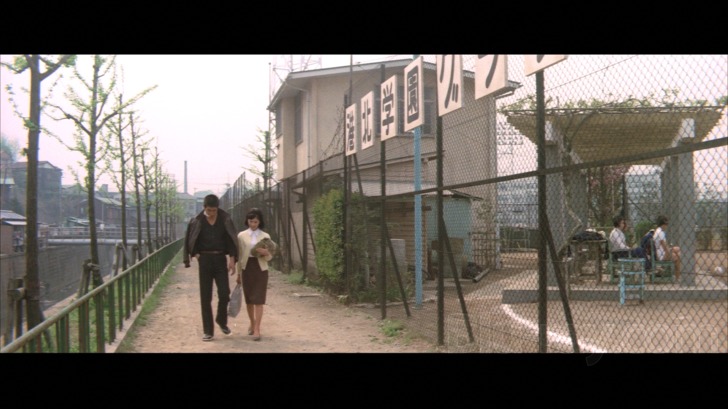
All six films in this set feature uncompressed LPCM Mono tracks in the original Japanese. None of the films is going to set audiophiles' hearts on fire, but with occasional exceptions (Black Dagger being the most noticeable one), there are few real problems with distortion or other age related issues. The films' dialogue and effects are typically rendered with decent force and fidelity, and the fun scores also sound decent, if narrow. Black Dagger receives the lowest audio score of any film in this set due to some distortion that's evident, most noticeably when music is playing.
Gangster VIP 2 Blu-ray Movie, Special Features and Extras 
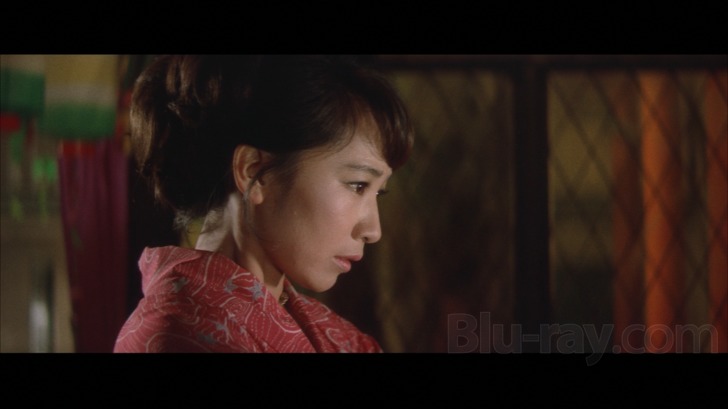
- Trailer (1080p; 2:35)
- Gallery (1080p)
Gangster VIP 2 Blu-ray Movie, Overall Score and Recommendation 
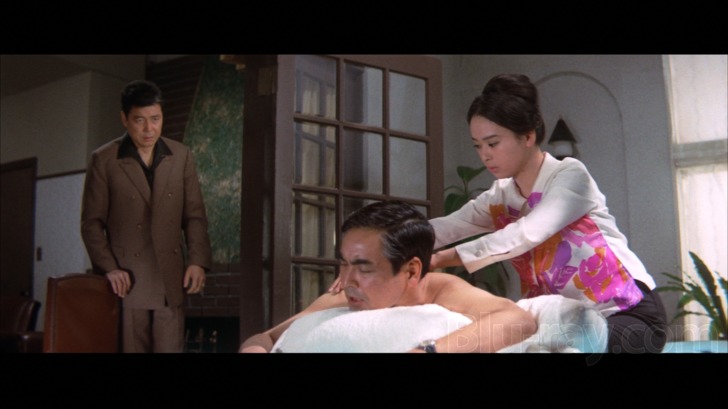
Gangster VIP 2 was early enough in this series that there were still a few "new" elements being thrown into the mix, and those give this film an enjoyable flavor, as well as keeping it at least slightly less derivative feeling than several of the subsequent films. Technical merits continue to have some slight problems, but are overall generally very good. Recommended.
Similar titles
Similar titles you might also like
(Still not reliable for this title)

Black Dagger
1968

Kill!
1969

Gangster VIP
1968

Goro the Assassin
1968

Heartless
1968

Massacre Gun
Minagoroshi no kenjū
1967

Hiroshima Death Match
Battles Without Honor and Humanity - Deadly Fight in Hiroshima
1973

Stray Cat Rock: Delinquent Girl Boss
1970

Dead or Alive 2
2000

Battles Without Honor and Humanity
1973

Proxy War
Battles Without Honor and Humanity
1973

Street Mobster
現代やくざ 人斬り与太 / Gendai yakuza: hito-kiri yota
1972

Eight Hours of Terror
8時間の恐怖 / Hachijikan no kyōfu
1957

Doberman Cop
ドーベルマン刑事 / Doberuman deka
1977

Detective Bureau 2-3: Go to Hell, Bastards!
探偵事務所23 くたばれ悪党ども / Kutabare akutō-domo - Tantei jimusho 23
1963

Graveyard of Honor
Jingi no hakaba
1975

New Battles Without Honor and Humanity: The Boss' Head
新仁義なき戦い 組長の首 / Shin jingi naki tatakai: Kumicho no kubi
1975

New Battles Without Honor and Humanity: Last Days of the Boss
新仁義なき戦い 組長最後の日 / Shin jingi naki tatakai: Kumicho saigo no hi
1976

New Battles Without Honor and Humanity
新仁義なき戦い / Shin jingi naki tatakai
1974

The Rambling Guitarist
ギターを持った渡り鳥 / Guitar wo Motta Wataridori
1959